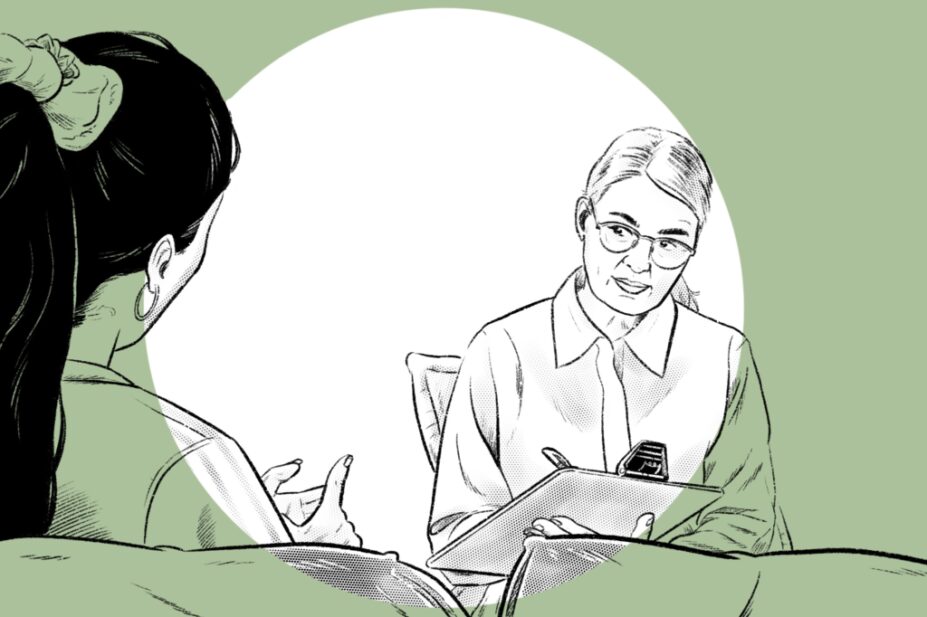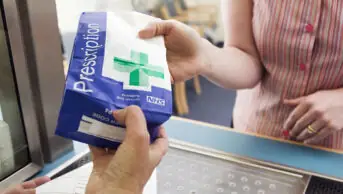
Wes Mountain/The Pharmaceutical Journal
By the end of this unit, you will be able to:
- Outline the common consultation models commonly used to support history taking;
- Understand the need to adapt the consultation approach to your area of practice;
- Identify tools used to gain an accurate history;
- Know the common mnemonics used in history taking.

RPS Competency Framework for all prescribers
This article aims to support the development of knowledge and skills related to the following competencies:
Domain 1: Assess the patient (1.1. 1.3, 1.6, 1.9)
- Undertakes the consultation in an appropriate setting;
- Introduces self and the prescribing role to the patient/carer and confirms the patient/carer identity;
- Takes and documents an appropriate medical, psychosocial and medication history, including allergies and intolerances;
- Assess and interprets all available and relevant patient records to ensure knowledge of the patient’s management is up to date.
Domain 3: Present options and reach a shared decision (3.6)
- Explores the patient’s/carer’s understanding of the consultation and aims for a satisfactory outcome for the patient/carer and prescriber.
History taking skills are fundamental for safe pharmacy practice and preparing to prescribe[1,2]. Gathering sufficient initial information to inform the prescribing process is a vital step and requires the establishment of a therapeutic relationship where the patient is invited by the prescriber to tell their health story. The role of the prescriber is to ensure the patient can divulge this story in a manner that is meaningful and aids the identification of symptoms, problems and feelings. As patients commonly tell their story in a manner personal to them, the use of consultation models and structured questions provide direction that ensures all the important questions are asked and essential information for diagnosis and management is obtained[1,3].
This article will summarise useful consultation models for history taking, describe their common principles and offer guidance on how to apply these tools in practice. It is recommended that you read this article in conjunction with these resources from The Pharmaceutical Journal:
- ‘Introduction to the prescribing consultation’;
- ‘Principles of person-centred practice for prescribing’;
- ‘Communication techniques for prescribing’.
To help further expand your prescribing skills, additional related articles are linked throughout. You will also be able to test your knowledge by completing a short quiz at the end of the article.
Initiating the consultation
Regardless of setting, the pre-consultation period is an opportunity to improve your clinical reasoning and influence the consultation, through reviewing appropriate clinical records, including medication lists, investigations and test results, and known conditions. As part of the preparation, attention should be given to the patient’s comfort, privacy and ability to consult within a safe environment[3,4]. The ability to truly provide this safe environment is a recognised challenge in many settings; the primary care practice and community pharmacy consulting rooms can offer a level of confidentiality that cannot be rigidly observed on hospital wards or during over-the-counter consultations in the pharmacy, with remote consultations presenting different challenges[5,6]. Although these barriers to privacy may not be fully overcome, anticipated issues should be acknowledged when engaging with the patient and efforts made to optimise the consultation environment for patients (Box 1). Their responses should be considered, recognising that interruptions and the potential to be overheard may influence the patient’s ability to tell their story[1,7]. The best approach is to check the patient’s preference and acceptance of the setting before commencing history taking[1,3].
Box 1: Reflection in practice
When preparing for a consultation how do you prepare the environment? What influence do you have over the environment?
Once the environment for the consultation has been established, you should introduce yourself in a manner that includes your name and role. Not only does this help to establish rapport, but it also defines to the patient your accountability to them, exposes your knowledge and expertise and defines the scope of how you will be able to support the patient during the consultation[8–10].
The patient’s identity should be confirmed as per accepted practice in your particular context (e.g. name, date of birth, address), as well as their carer/chaperone[11–13]. Once this has been established, you can then progress to the subsequent stages of the consultation.
Gathering information
Completing an accurate history can provide much of the information that you need to inform your diagnosis and prescribing decisions[14]. There are many techniques and models that can be employed to undertake a history and the choice of approach will be influenced by the clinical setting, speciality and the condition the patient presents with as well as the individual preferences of the prescriber. In all instances, a systematic and structured approach to history taking is crucial. This structured approach needs to be scaffolded onto an existing framework of expert clinical knowledge, pharmacological understanding and diagnostic skills[4]. This is supported by working within your defined scope of practice.
Regardless of the model used, a clinical history should be able to discover a patient’s health concerns based on an understanding of the presenting complaint, other conditions and general health, allergies, medications and their family and social history. This may also be corroborated with physical examinations, diagnostic tests, blood test and other relevant investigations.
A commonality of all approaches is that during the history taking phase, the use of open questions and tools such as the ‘golden minute (giving the patient a minute to speak without interruption)’ will enable the patient to tell their story, feel listened to and lay the foundation for building rapport. Questions such as “How can I help you today?” or “What brought you here today?” can meet the needs of the patient, while focusing on the reason for the consultation and help with time management’.
For more detail on questioning techniques, see ‘Communication skills for prescribing’.
Once the patient has completed their account of the issue, it is valuable to summarise the patient’s story so that any ministrations can be clarified before you use more specific questions to explore the issue more deeply[3].
Complaint
The presenting complaint is often considered the patient’s priority issue and provides a good starting point for the consultation, in addition to asking the patient what they think the issue is, you will need to consider what the diagnostic options are at this stage and use appropriate questions and physical assessments to develop your understanding of the patient’s concern[14].
It may be helpful to use systematic questions (common mnemonics) to clarify the symptoms and gather as much information as possible from the patient.
For gathering information about symptoms, there are several tools — such as ‘PQRSTU’ and ‘SOCRATES’ — that can be useful for assessing a range of conditions. They are most commonly used for acute symptoms such as pain, shortness of breath and minor ailment presentations, but could be adapted for a wide variety of conditions[14].
While investigating the history of the presenting complaint, it is important to be vigilant for ‘red flag’ symptoms and to specifically ask questions relating to these with a goal of recognising an acute emergency or life-limiting concern[15]. In practice this could be new onset radiating chest pain, where differentiating questions could include: “Please describe what you were doing when the symptoms started” or “Are there any other symptoms that you experience alongside this pain?” and “On a scale of 1 to 10, how severe would you rate the pain?” Responses more indicative of a red flag scenario would be pain on excretion, sweating or difficulty breathing and a higher pain score. A further less acute example is significant unintentional weight loss for a person with new onset constipation, the probing questions here could include: “Have you made any intentional changes to your diet/ nutritional intake?” or “Have you been intentionally trying to reduce your body weight?”[15,16].
Past medical history and other current conditions
As you explore the presenting complaint, this will need to be considered in the context of the past medical history, both in terms of it being linked to this, but also considering risk factors and contraindications for prescribing decisions. It should include other current conditions, and significant past illnesses. It may be helpful to use the mnemonic ‘MJTHREADS’ to help identify these (see Box 2).
Box 2: Focus on practice — the ‘MJTHREADS’ mnemonic for establishing significant illnesses
M – Myocardial Infarction
J – Jaundice
T – Tuberculosis
H – Hypertension
R – Rheumatic fever
E – Epilepsy
A – Asthma
D – Diabetes
S – Stroke
When a person has been living with a condition for a long time, they may not consider it relevant and so probing and prompting questions should be used. Open questions such as: “How is your general health?” can be valuable, but it may be useful to ask more direct questions if they are pertinent to the current diagnosis and plan, for example: “Have you had any recent hospital admissions? If so, what for?” or “Do you have any heart problems?”
A comprehensive review of medication history forms part of a full history and, although shared systems and technology may mean that you have access to this information during the preparation stage of the consultation, confirming the patient’s adherence and understanding of their medicines can help inform your diagnosis and treatment plan. Medication history taking needs to be practiced and there are several tools to assist in this, one example being the ‘PILLS’ mnemonic[17–19] (see Box 3). Taking a detailed medication history is key to reducing the risk of making a prescribing error[20,21].
Box 3: Focus in practice — using the ‘PILLS’ systematic questions medication history taking
P – regular pills
Example question: Please tell me about any prescribed medication that you are taking. Do you get any medicines prescribed from somewhere other than your GP?
I – injections/insulins/inhalers
Example question: Do you take any medicines that are not taken by mouth; for example, any inhalers, patches, injections or insulin?
L – illicit and recreational drugs, including cigarettes and alcohol
Example question: Do you take any social or recreational substances; for example, cigarettes, alcohol, or items you buy or borrow from friends, neighbours or the internet?
S – sensitivities and allergies
Example question: Have you ever experienced an allergy to a medicine? Are there any medicines that you prefer not to take as you have experienced a side effect or sensitivity?
Family and social history
The place for considering smoking, alcohol and recreational drug use bridges both the drug history and social history components of the information gathering process. This topic may be challenging to address and so providing a context for the question can be valuable; for example, explaining that you are going to ask questions to help establish if the person is at risk of withdrawal symptoms, or that many social and recreational drugs interact with commonly prescribed medicines and so you want to consider the potential interactions in a way that is meaningful to them as an individual. Each scenario will be different, and you will need to use your emotional intelligence, experience and intuition to judge the exact approach.
Regardless of where exactly it fits within the specific context of the consultation, smoking, alcohol and recreational drug use must be addressed in terms of the how much the patient uses and how often. Specifically for alcohol, the ‘CAGE’ approach can be useful for completing an alcohol history review (see Box 4). This approach requires a simple yes (score 1) or no (score 0) response to a short series of questions: a score of 2 would be indicative of potential alcohol misuse. As a prescriber, the potential for interactions with alcohol or the cumulative sedative effects and associated risks should be considered as part of your clinical decision making and you should consider signposting the patient to appropriate services[22].
Box 4: Focus in practice — using the ‘CAGE’ approach for completing an alcohol review
C: Have you ever felt the need to cut down?
A: Do you feel annoyed by people questioning your alcohol consumption?
G: Do you feel guilty about drinking alcohol?
E: Do you need an ‘eye opener’ in the morning to face the day?
Social, family and occupational history are valuable sections of the history as they may inform the risk of some conditions, but also give insight into the potential health beliefs and support network the patient has. It can also reveal non-medical factors such as a person’s social and economic circumstances, with poorer people more likely to experience poor health and worse health outcomes[23,24]. Recent and historical occupational exposure may be related to current presenting symptoms. Full discussion of health inequalities and the social determinants of health is beyond the scope of this article but additional information on these topics is available at the end of the article.
Next steps
History taking alone can often be sufficient to inform the diagnosis or may indicate that further diagnostic investigations are required. Where indicated, the next step could include a review of body systems[25]. A thorough understanding of the common characteristics of the presenting signs and symptoms for the potential presenting body systems is required. This should take a logical approach and depending on the presenting complaint may take the form of a focused system review or a more general/holistic one (e.g. a head-to-toe physical assessment)[1].
The systems review may then be supported by appropriate physical assessments and requesting of diagnostic tests where indicated.
Case in practice
 Patient profile: Mr Singh, aged 63 years, is visiting a pharmacist prescriber in the minor ailments clinic in the primary care walk in centre. He has had a chesty cough for around three weeks. He is active in his community and is part of volunteer group that provides meals for the local homeless population. He is normally fit and well, he has no prescribed medicines and buys occasional analgesia.
Patient profile: Mr Singh, aged 63 years, is visiting a pharmacist prescriber in the minor ailments clinic in the primary care walk in centre. He has had a chesty cough for around three weeks. He is active in his community and is part of volunteer group that provides meals for the local homeless population. He is normally fit and well, he has no prescribed medicines and buys occasional analgesia.
Background: The prescribing pharmacist discusses the presenting complaint of cough and uses and adapted ‘SOCRATES’ and ‘MJTHREADS’ mnemonics to guide their questions.
SOCRATES
Site: Can you describe the cough? Do you feel you need to cough because of a tickle in your throat or deeper sensation in your chest?
Onset: When did the symptoms start?
Character: How would you describe the issue?
Radiation: Have the symptoms changed or moved?
Associated symptoms: Do you have any other symptoms?
Timing: Can you describe how the symptoms have changed over time?
Exacerbating and relieving factors: Does anything change the severity of the symptoms?
Severity: On a scale of 1 to 10, How would you rate the symptoms?
Reflective questions
1. What are the differentiating responses to the ‘SOCRATES’ model that will guide your diagnosis?
2. Which details from the patient’s social history are alerting you to the potential differential diagnosis other than a simple seasonal cough?
3. Which other questions would you need to ask to explore other potential red-flag conditions?
4. Which other assessments or investigations would support your consultation?
Answer guidance is available at the end of the article.
Documentation
It is essential that information gathered is appropriately documented in the patient record, including all actions taken as a direct result of the history (e.g. physical examination, diagnostic tests). Using a structured form of documentation will also help act as a prompt to ensure you have covered all necessary elements of the history-taking process.
Summary
It is important to acknowledge that your history-taking skills will develop over time, with experience and reflective practice. Early in your prescribing career your skills will need to be honed relating to your scope and level of practice, with a planned approach to developing these further.
Within a comprehensive consultation, following the history taking process, a diagnosis may be formed that will lead to shared plan of care in conjunction with the patient, which may include prescribing decisions.
Questions for reflection
1. This article has considered a general approach to history within a structured approach to consultation models. Within your role you are likely to meet patients from the breadth of society. Think about the people you may meet within your role. How might you need to prepare and adapt your communication skills and consultation approach for those who may have particular needs (e.g. children, learning disabilities, neurodiversity, hard of hearing, registered blind etc.)?
2. Which strategies could you employ to ensure that you do not miss any essential information when taking a patient history?
Activities to complete for your role and workplace
What things may you need to consider when preparing to obtain information from a patient who has particular communication needs? What tools of facilities do you have access to support patients with different needs. Do you have access to translation services, materials in different formats?
If difficult information is given during the time, what tools or services do you have access to for signposting or dealing with these things appropriately? Are you aware of the safeguarding procedures for your area?
Each unit should contain one or two activities that provide an opportunity for active learning. They can be effective at expanding on a complex concept or applying theory to practice. Activities should also support the cross-cutting themes of the collection (see above) of person-centred practice, patient safety and critical appraisal.

Test your knowledge

Expanding your scope of practice
The following resources expand on the information contained in this article:
History taking tools and techniques
- ‘The SOCRATES acronym in history taking‘, Geeky Medics;
- ‘The importance of assessing pain in adults‘, Nursing Times;
- ‘The PQRSTU Assessment‘, The Complete Subjective Health Assessment;
- ‘CAGE alcohol questionnaire‘, The European Monitoring Centre for Drugs and Drug Addiction (EMCDDA);
- ‘Medical Mnemonics‘, Medical Student Mnemonics.
Health inequalities
- ‘Social determinant of health‘, Public Health England;
- ‘What makes us healthy?‘, The Health Foundation.
Answer guidance for case in practice
1 — The differentiating answers to the SOCRATES model are:
S: To consider if this is a simple cough associated with an upper respiratory tract infection or if the mucous is coming from deeper in the lungs.
O: An acute cough is considered to last less than three weeks and is commonly associated with acute viral infection although there are other causes. A cough lasting three weeks or more requires appropriate examinations and investigations to be undertaken to identify the cause.
C: The patient should be encouraged to describe the presence or absence if mucous, its colour, consistency and specifically if there is any blood present. Presence of blood should be specifically explored for amount and colour.
R: This is to explore if this started as a typical upper respiratory tract infection that has not resolved.
A: Key symptoms to be explored include those that are associated with red flag conditions for example unintentional weight loss linked to cancer or tuberculosis, night sweats for tuberculosis or haemoptysis.
T: As for Onset, looking to explore when the symptoms presented and if they have changed over time. If the symptoms have improved since their initial presentation this is less concerning than a person reporting a cough that started three weeks ago, and they have noticed that is has become streaked with blood in the previous few days,
E: This may include descriptors of the symptoms being worst in the morning, only having fever and sweats at night or positive changes such as the symptoms improving whilst on holiday, differentiating an upper respiratory tract infection form potential tuberculosis and occupational asthma respectively.
S: How much are the symptoms impacting on the persons life?
2 — The patient’s volunteer role increase his exposure to a population of people more likely to have tuberculosis, this therefore increases his risk of tuberculosis.
3 — As partly discussed is part 1, the key symptoms that should be directly asked are related to unintentional weight loss and/or the presence of blood in the mucous. Symptoms such as night sweats or sudden onset chest pain would also require further investigation.
4 — Initially, the patient’s temperature and O2 levels should be checked, alongside a thorough chest examination. It may be necessary to refer for chest X-rays for a more definitive diagnosis, depending on the outcome of the consultation.
- 1Kaufman G. Patient assessment: effective consultation and history taking. Nursing Standard. 2008;23:50–6. https://doi.org/10.7748/ns2008.10.23.4.50.c6677
- 2Delivery plan for recovering access to primary care. NHS England. 2023. https://www.england.nhs.uk/long-read/delivery-plan-for-recovering-access-to-primary-care-2 (accessed November 2023)
- 3Crumbie A. Taking a history . Nurse Practitioners: Clinical Skill and Professional Issues. Boston, MA: Butterworth-Heinemann 1999:320. https://search.worldcat.org/title/nurse-practitioners-clinical-skills-and-professional-issues/oclc/777313531 (accessed November 2023)
- 4Young K, Franklin P. Effective consulting and historytaking skills for prescribing practice. Br J Nurs. 2009;18:1056–61. https://doi.org/10.12968/bjon.2009.18.17.44160
- 5Oliver D. David Oliver: Confidentiality on the wards—regulations and reality. BMJ. 2017;j1253. https://doi.org/10.1136/bmj.j1253
- 6In practice: Guidance on confidentiality. General Pharmaceutical Council. 2018. https://www.pharmacyregulation.org/sites/default/files/document/in_practice_guidance_on_confidentiality_june_2018.pdf (accessed November 2023)
- 7While A. Practical skills: prescribing consultation in practice. Br J Community Nurs. 2002;7:469–73. https://doi.org/10.12968/bjcn.2002.7.9.10658
- 8Granger K. Healthcare staff must properly introduce themselves to patients. BMJ. 2013;347:f5833–f5833. https://doi.org/10.1136/bmj.f5833
- 9‘Person-centred care made simple. What everyone should know about person-centred care’. The Health Foundation. https://www.health.org.uk/publications/person-centred-care-made-simple (accessed November 2023)
- 10Murray J. The Professional Introduction. AJN, American Journal of Nursing. 2016;116:13. https://doi.org/10.1097/01.naj.0000505567.11376.bc
- 11Riplinger L, Piera-Jiménez J, Dooling JP. Patient Identification Techniques – Approaches, Implications, and Findings. Yearb Med Inform. 2020;29:081–6. https://doi.org/10.1055/s-0040-1701984
- 12Online pharmacies required to verify patient ID before prescribing, under new GPhC guidelines. The Pharmaceutical Journal. 2019. https://doi.org/10.1211/pj.2019.20206431
- 13Patient Identification: Patient Safety Solutions. World Health Organization Collaborating Centre for Patient Safety Solutions . 2007. https://cdn.who.int/media/docs/default-source/patient-safety/patient-safety-solutions/ps-solution2-patient-identification.pdf?sfvrsn=ff81d7f9_6 (accessed November 2023)
- 14Bickley LS, Szilagyi PG, Hoffman RM, et al. Bates’ Guide To Physical Examination and History Taking. 13th ed. Lippincott Connect 2023. https://www.lww.co.uk/9781975210540/bates-guide-to-physical-examination-and-history-taking/ (accessed November 2023)
- 15C. Ramanayake RPJ, K. Basnayake BMT. Evaluation of red flags minimizes missing serious diseases in primary care. J Family Med Prim Care. 2018;7:315. https://doi.org/10.4103/jfmpc.jfmpc_510_15
- 16Stevens D. A sore throat or something else? Practice Nursing. 2008;19:83–5. https://doi.org/10.12968/pnur.2008.19.2.28171
- 17Strickland-Hodge B. The Prescribing Pharmacist. M&K Update 2019.
- 18Bradbury H, Strickland-Hodge B, McKimm J, et al. Practical Prescribing for Medical Students. 2014. https://doi.org/10.4135/9781526401793
- 19Medical Mnemonics. Geeky Medics. https://geekymedics.com/medical-mnemonics/ (accessed November 2023)
- 20Lewis PJ, Dornan T, Taylor D, et al. Prevalence, Incidence and Nature of Prescribing Errors in Hospital Inpatients. Drug Safety. 2009;32:379–89. https://doi.org/10.2165/00002018-200932050-00002
- 21Ryan C, Ross S, Davey P, et al. Prevalence and Causes of Prescribing Errors: The PRescribing Outcomes for Trainee Doctors Engaged in Clinical Training (PROTECT) Study. PLoS ONE. 2014;9:e79802. https://doi.org/10.1371/journal.pone.0079802
- 22Ewing JA. Detecting Alcoholism. JAMA. 1984;252:1905. https://doi.org/10.1001/jama.1984.03350140051025
- 23Social Determinants of Health . Public Health England. 2017. https://www.gov.uk/government/publications/health-profile-for-england/chapter-6-social-determinants-of-health (accessed November 2023)
- 24Lovell N, Bibby J. What makes us healthy? An introduction to the social determinants of health. The Health Foundation. 2018. https://www.health.org.uk/publications/what-makes-us-healthy (accessed November 2023)
- 25Summerton N. The medical history as a diagnostic technology. Br J Gen Pract. 2008;58:273–6. https://doi.org/10.3399/bjgp08x279779




